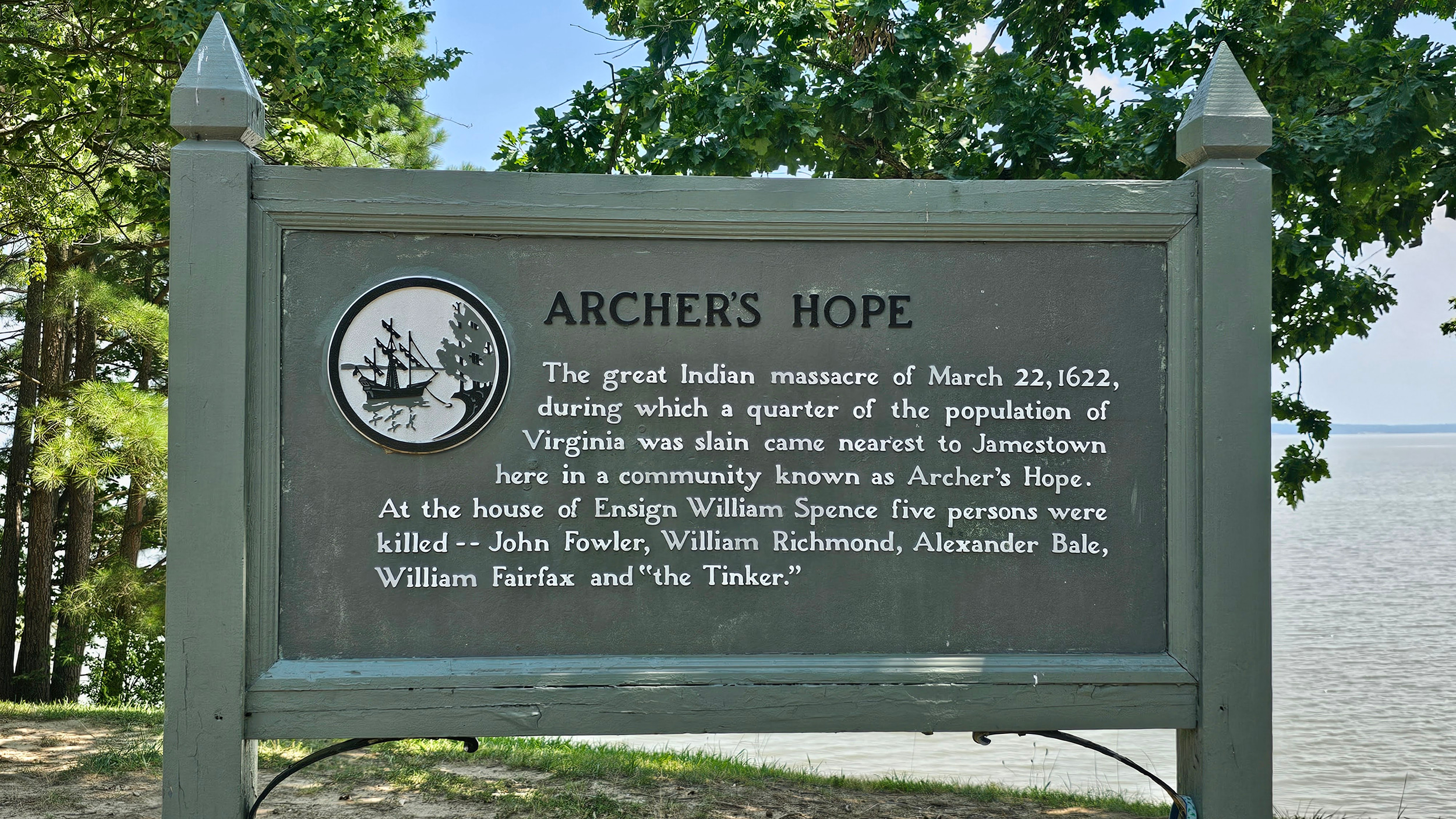In July of 2025 we traveled to Jamestown Settlement in Williamsburg, Virginia. On our way back to our hotel, we found an intriguing location to stop and check out. The story of Archer's Hope is one of those locations that, if not for the historical marker, may be lost to the ages.

During our trip to Jamestown in the summer of 2025, we did not expect to stumble on an unplanned historical detour. After spending most of the day out in the heat walking around the Jamestown settlement, we were more than ready to head back to our hotel in Williamsburg and cool off. The sun had been relentless, the humidity thick, and by the time we got back into the car, we were grateful for the quick blast of cold air. Little did we know that a closed road would lead us to another unexpected piece of history.
As we followed the detour signs, weaving through tree-lined backroads that hugged the river, we noticed a historical marker ahead on the right. For anyone who loves history the way we do, a marker is an invitation you cannot ignore. Even though we were overheated and tired, we knew we had to stop. The moment we pulled into the small parking lot by the James River, it felt like stepping into a quiet pocket of the past.
The historical placard read Archers Hope. Neither of us had heard of it before, and that alone piqued our curiosity. We let the car idle with the air conditioner running as we sat in the shade of the trees overhead. The James River was calm in front of us, moving slowly with the summer breeze, and the spot felt peaceful and almost untouched. It seemed strange to think that this quiet place had once been considered for one of the most important settlements in American history.
As we cooled off, we pulled out our phones and began researching the location. We quickly learned that Archer's Hope had been one of the first sites the English explored in 1607 before choosing Jamestown. Captain Gabriel Archer believed the area would be a better location because of its access to fresh water, high ground, and fertile land. Many scholars now think he may have been right. The area would have offered far better conditions than the swampy and disease-ridden island where the famous settlement was eventually built.
We also learned that long before the English arrived, this region was part of the homeland of the Powhatan people. The forests, marshes, and riverbanks had supported Native communities for generations. They fished the James River, hunted the woodlands, and cultivated crops in the fertile soil. To them, this land was not a potential colony but a living part of their world, connected to their families, their traditions, and their survival.
The more we read, the more we realized how significant this place actually was. Archers Hope represented a moment of crossroads not only for the English settlers but for the Powhatan Confederacy as well. The arrival of the English created tension, uncertainty, and eventually conflict as both groups navigated unfamiliar relationships and competing needs for land and resources. This peaceful shoreline once stood in the middle of a rapidly changing world.
We were reminded that in the years that followed, relations between the settlers and the Powhatan grew increasingly strained. One of the most significant events took place on March 22, 1622, when the Powhatan launched a series of surprise attacks against English settlements along the James River. Hundreds of colonists were killed in a single coordinated morning assault. It was a powerful moment that reshaped the history of the early colony and stood as a response to years of encroachment and cultural conflict.
Sitting there by the river, it was easy to imagine how these tensions would have played out near Archer's Hope. The same calm water in front of us once carried canoes, fishing nets, and patrol boats. The same wooded shoreline once bore witness to both cooperation and confrontation. It made the landscape feel heavier with memory, a place where two worlds collided with lasting consequences.
After reading page after page and diving deeper into the story, we felt a growing connection to the spot. It did not have the crowds or reconstructed buildings of Jamestown. Instead, it had something rare: an untouched authenticity. You could sit there and feel the landscape much as both the early explorers and the Native people would have seen it, with the wide-open river and the tree-covered shoreline stretching out in both directions.
We talked about how these forgotten places often hold just as much history as the popular sites everyone visits. Archers Hope was not a name that shows up on most tourist brochures, but the story behind it was just as important. And as we sat there taking it all in, there was a quiet stillness that made the experience even more meaningful.
Once we finished reading about the site, we decided to take advantage of the peaceful moment and conduct a spirit box session right there in the car. We were still cooling down and did not feel like getting back out into the intense heat, but we knew that moments like this can produce some unexpected results. The location had the perfect combination of history, isolation, and lingering energy.
We turned on the spirit box and let the sweeping static fill the car. At first, everything was quiet, but after about a minute, faint voices began to push through the noise. Some of the responses were quick, single-word answers that we could not fully interpret, but others came through surprisingly clear. It felt as though someone or something was aware that we were asking questions.
One of the clearer responses came when we asked about the early settlers. A male voice seemed to say the word "choice," which instantly caught our attention because of the history we had just researched. Another faint voice sounded like it said "river" or maybe "water." Whether it was coincidence or something more, the timing was difficult to ignore.
As the session continued, we noticed that the atmosphere in the car changed. It was still peaceful outside, but inside, the air felt heavier in a way we have come to recognize during paranormal work. The responses grew somewhat more frequent, though still scattered, and at times it felt like someone was trying to push through the static just enough to be heard.
We wrapped up the spirit box session after several minutes, partly because we were finally cooling off and partly because the heat of the day had worn us out. Still, we both agreed that the results were intriguing enough to make the stop worthwhile. What started as a detour had turned into a historical discovery and a mini investigation all in one.

Before leaving, we sat for another moment and looked out over the James River. The sun was lower in the sky, and the golden light reflected on the water. It was the kind of view that makes you understand why the early Powhatan and the English explorers saw so much promise in this place. Even without the reconstructed buildings or museum displays, this little stretch of shoreline carried a quiet power.
As we pulled back onto the road and continued toward Williamsburg, we talked about how unexpected stops like this often become some of the most memorable parts of our travels. Archers Hope had been an overlooked footnote in the history books, yet for us, it became one of the most intriguing discoveries of our day. A closed road may have altered our route, but it ended up leading us to a story with deeper layers than we could have imagined.
By the time we reached Williamsburg, the sun was beginning to set and the heat of the day was finally starting to fade. We were tired, but we were also grateful. Archer's Hope had given us a chance to explore another layer of Jamestown history, reflect on the lives of the Powhatan people, and experience a quiet moment by the river. It was a reminder that history is all around us, sometimes waiting on the side of the road behind a simple wooden sign.












